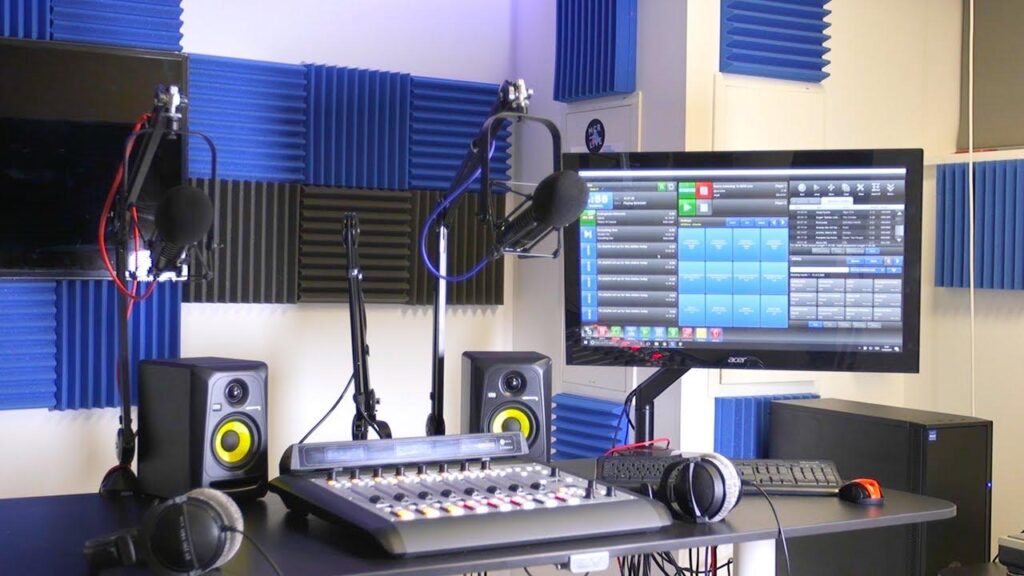In the world of audio broadcasting and recording, innovation has played a critical part in shaping the way we capture and transmit sound. From the earliest days of radio to the modern era of music production, the demand for crisper audio has driven the development of cutting-edge equipment.
Phantom power is part of such innovations that have streamlined audio content creation. In this article, we will find the solution to the question about the use of phantom power for the RE320 mics.

What is Phantom Power?
Phantom power is a method of providing electrical power to certain types of audio equipment, primarily condenser microphones and some active direct boxes (DI boxes). This power is typically supplied through a balanced audio cable, such as a 3-pin XLR cable. In addition, these power supplies serve a crucial role in ensuring the proper functioning of these devices.
Condenser microphones, unlike dynamic microphones, require an external power source to operate because they contain active electronic components. These components may specifically include an internal preamplifier and an electrostatic transducer. So, phantom power is the industry-standard method for delivering this required power to condenser microphones.

Everything You Need to Know About RE320 Microphones
The RE320, or Electro-Voice RE320, is a dynamic microphone designed for professional audio applications. It’s part of the RE (Recording and Engineering) series of microphones produced by Electro-Voice, a renowned manufacturer of audio equipment. Professionals make use of these mics to enhance the quality of the output sound while recording and broadcasting.

Key Features
- Like its predecessor, the RE20, the RE320 is a dynamic microphone. These microphones are known for their durability and ability to handle high sound pressure levels, making them suitable for a wide range of recording scenarios.
- The RE320 features Variable-D technology to help minimize the proximity effect. This will ensure a consistent frequency response even when the microphone is used at different distances from the sound source. This is especially beneficial for broadcast and voiceover applications, where it is necessary to avoid positional and off-axis tonal shifts.
- The microphone is known for its versatility in capturing sound. It can be used for recording vocals, musical instruments, podcasting, broadcasting, and more. Its wide frequency response and natural sound reproduction make it suitable for various audio sources. You can also find a unique dual-voicing switch that selects from two response curves.
- RE320 mics have an integrated pop filter to reduce plosive sounds such as “p” and “b” sounds and wind noise, making it well-suited for voice recording. It also comes with a neodymium capsule that handles high SPL levels of sound during recording. This effectively helps in capturing the transient signals from amplifier cabinets.
Do You Need Phantom Power for RE320 Microphones?
Now that you have a basic know-how of the phantom power, let’s dig deep into its application to get a better idea of its functionality. Even though you do not require phantom power for dynamic mics like RE320, it has applications for condenser mics. Where the use of phantom power in dynamic mics is considered a hazard, the recording community is not observed to utilize it in any case.
Instead, phantom power is generally observed for condenser mics such as Scarlett 2i2 or Behringer XENYX 802. Make sure that the setup designed for recording does not necessarily include a phantom power source when using RE320 mics.

How to Set Up Your Mixer for RE320 Microphones?
You might be wondering how to set up your RE320 microphone with phantom power. As discussed earlier, dynamic mics do not require phantom power for functioning. However, with the help of the following simple steps, you can streamline your audio setup with these power supplies.
Step 1: Ensure Compatibility of the Mixer with Your RE320 Mic
First, confirm that your mixer or audio interface provides phantom power and that it is compatible with dynamic and condenser microphones that require phantom power. The RE320 is a dynamic microphone, so it does not need phantom power to operate. However, if your mixer has a switchable “Phantom Power” button or switch, make sure it is set to the “Off” position when using the RE320.
Step 2: Connect the RE320 Mic to the Mixer
Plug one end of an XLR cable into the output of your RE320 microphone. The XLR connector has three pins and is the standard connector for microphones. Connect the other end of the XLR cable to one of the mixer’s XLR microphone input channels.
Step 3: Adjust Mixer Settings
On your mixer, select the channel corresponding to the RE320 microphone. If there is a gain or trim control for the channel, set it to an appropriate level to achieve a good signal-to-noise ratio without overloading the input. Start with the gain control at a low setting and gradually increase it while monitoring the signal level.
Step 4: Turn Phantom Power Off
As mentioned earlier, the RE320 is a dynamic microphone and does not require phantom power. Therefore, you have to ensure the power switch on your mixer is turned off or set to the “0” position. Applying phantom power to a dynamic microphone like the RE320 is unnecessary and can potentially damage the microphone.
Application of RE320 in Audio Content Creation
The Electro-Voice RE320 microphone has proved to be a versatile tool for professional audio applications. It contains a dynamic microphone design and durability, making it perfect for audio content creation. The following are some of the common applications for the RE320 mics:
- Studio Recording: Musicians and audio engineers often use the RE320 for recording vocals and musical instruments in studio environments. Its wide frequency response and switchable dual-voice modes (normal and kick drum) allow it to adapt to various recording scenarios.

- Live Sound Reinforcement: The RE320 can be a stage microphone for live performances. It excels at capturing the sound of vocalists and instruments, providing excellent feedback rejection due to its cardioid polar pattern.

- Instrument Miking: Any musician can take advantage of these mics to record instruments such as acoustic guitars and other brass instruments. They can also record the drum sound due to the ability of the RE320 to handle high sound pressures.

- Podcast Interviews: Podcasters can make use of these dynamic mics to record audio content during interview sessions. With the help of its directional characteristics, RE320 will help them capture the voices of both the host and guest with clarity.

Tips to Get the Best Out of RE320
The following tips will help you get the best out of the RE320 mics. So, make use of these informative tips to streamline your audio content creation:
- Choose the Right Mode: The RE320 has two sound profiles, “Normal” and “Kick Drum.” Select the appropriate mode for your application. “Normal” mode provides a flat and natural response, suitable for vocals and most instruments. “Kick Drum” mode is tailored for capturing the low-frequency punch of kick drums and bass instruments.
- Optimize Mic Placement: Position the microphone correctly for the source you’re recording. For vocals, place the microphone at mouth level and slightly off-axis to reduce plosives and sibilance. You can also experiment with mic placement to find the sweet spot that captures the desired sound of the instruments.
- Use a Pop Filter: As mentioned in this article, the RE320 has integrated pop filters. However, you can also use an external pop filter to reduce the plosive sounds.
- Use Shock Mount and Stand: To reduce handling noise and vibrations, use a shock mount to suspend the microphone. A sturdy microphone stand or boom arm can also help position the RE320 accurately.
- Avoid Phantom Power: The RE320 is a dynamic microphone and does not require phantom power to function properly. So, you need to ensure that phantom power is turned off on your mixer or audio interface when using the RE320. If you leave it turned on, phantom power can damage your RE320 microphone.
FAQs Related to RE320 and Phantom Power
Q1. What audio recording devices require phantom power?
Condenser microphones, active direct boxes, and some active ribbon microphones require phantom power for their operation. Other microphones, including dynamic mics and passive ribbon microphones, do not rely on phantom power to operate in full flow. Moreover, this phantom power is even harmful to some mics like RE320.
Q2. Does the RE320 microphone need phantom power?
No, the RE320 microphone is a dynamic microphone and does not require phantom power for operation. Applying phantom power to the RE320 is unnecessary and could harm the microphone. So, you have to avoid using phantom power while working with the RE320 mics.
Q3. Can phantom power damage RE320 microphones?
Applying phantom power to an Electro-Voice RE320 microphone has the potential to harm the mic. As RE320 is a dynamic microphone, it is designed to operate without requiring phantom power. Phantom power may or may not have some adverse effects on the RE320 mics. So, it’s crucial to ensure that phantom power is turned off on your mixer when using the RE320.
Q4. Can I make use of a condenser mic without phantom power?
No, most condenser microphones require phantom power because they have active electronics inside. Without phantom power, a condenser microphone will not function properly, and you will not get any audio output. However, musicians can take advantage of dynamic mics without using phantom power.
Conclusion
As discussed throughout the article, phantom power is unsuitable for dynamic mics like RE320. However, you can use this power supply to optimize the working of condenser microphones. We hope that this article is successful in clearing your doubts about whether to use phantom power for the RE320 mics or not.
While exploring microphone requirements like phantom power for the RE320, it’s also valuable to consider convenient wireless options for audio content creation. A wireless lavalier microphone can simplify recording setups and boost flexibility, making your production workflow smoother.
Best Seller
Sale

Hollyland LARK M2S – Wireless Clip-on Microphone
- 7g Lightweight, Titanium Clip, Discreet Design
- Clear sound with 24-bit/48kHz, 70dB SNR, 116dB SPL
- Noise Cancellation & 300m Long-Range Stability
- Works with Camera/iPhone/Android/Laptop
- Perfect for Content Creators, Online-Teaching, Streaming
$139
$159
































.png)






